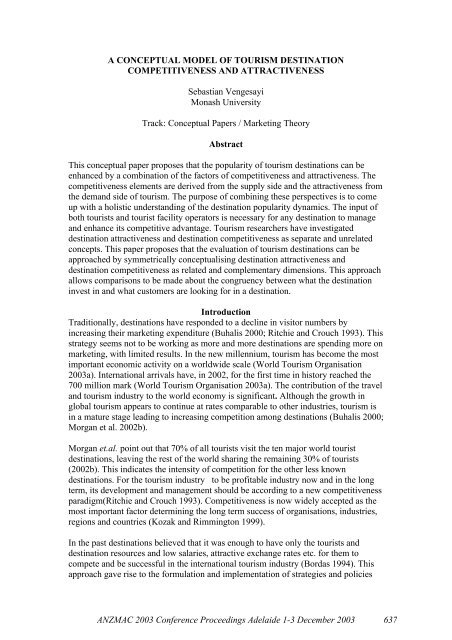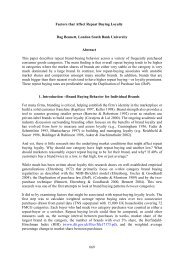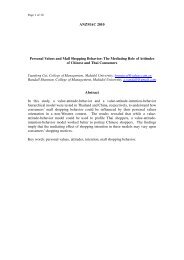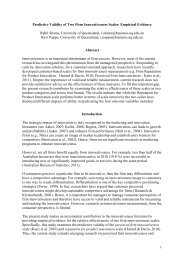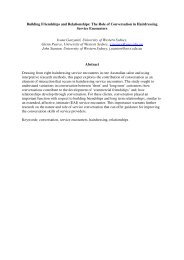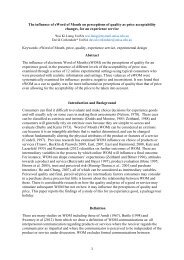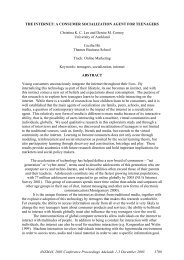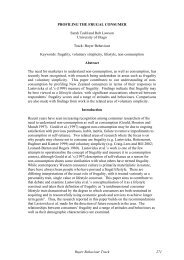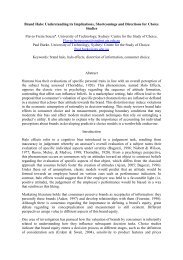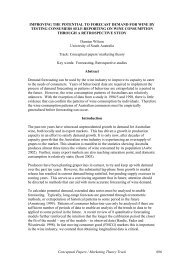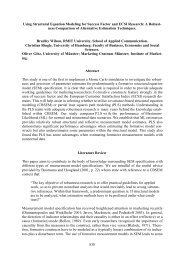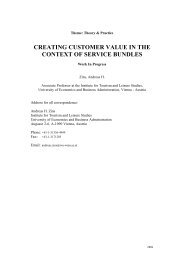A CONCEPTUAL MODEL OF TOURISM DESTINATION ...
A CONCEPTUAL MODEL OF TOURISM DESTINATION ...
A CONCEPTUAL MODEL OF TOURISM DESTINATION ...
Create successful ePaper yourself
Turn your PDF publications into a flip-book with our unique Google optimized e-Paper software.
A <strong>CONCEPTUAL</strong> <strong>MODEL</strong> <strong>OF</strong> <strong>TOURISM</strong> <strong>DESTINATION</strong><br />
COMPETITIVENESS AND ATTRACTIVENESS<br />
Sebastian Vengesayi<br />
Monash University<br />
Track: Conceptual Papers / Marketing Theory<br />
Abstract<br />
This conceptual paper proposes that the popularity of tourism destinations can be<br />
enhanced by a combination of the factors of competitiveness and attractiveness. The<br />
competitiveness elements are derived from the supply side and the attractiveness from<br />
the demand side of tourism. The purpose of combining these perspectives is to come<br />
up with a holistic understanding of the destination popularity dynamics. The input of<br />
both tourists and tourist facility operators is necessary for any destination to manage<br />
and enhance its competitive advantage. Tourism researchers have investigated<br />
destination attractiveness and destination competitiveness as separate and unrelated<br />
concepts. This paper proposes that the evaluation of tourism destinations can be<br />
approached by symmetrically conceptualising destination attractiveness and<br />
destination competitiveness as related and complementary dimensions. This approach<br />
allows comparisons to be made about the congruency between what the destination<br />
invest in and what customers are looking for in a destination.<br />
Introduction<br />
Traditionally, destinations have responded to a decline in visitor numbers by<br />
increasing their marketing expenditure (Buhalis 2000; Ritchie and Crouch 1993). This<br />
strategy seems not to be working as more and more destinations are spending more on<br />
marketing, with limited results. In the new millennium, tourism has become the most<br />
important economic activity on a worldwide scale (World Tourism Organisation<br />
2003a). International arrivals have, in 2002, for the first time in history reached the<br />
700 million mark (World Tourism Organisation 2003a). The contribution of the travel<br />
and tourism industry to the world economy is significant. Although the growth in<br />
global tourism appears to continue at rates comparable to other industries, tourism is<br />
in a mature stage leading to increasing competition among destinations (Buhalis 2000;<br />
Morgan et al. 2002b).<br />
Morgan et.al. point out that 70% of all tourists visit the ten major world tourist<br />
destinations, leaving the rest of the world sharing the remaining 30% of tourists<br />
(2002b). This indicates the intensity of competition for the other less known<br />
destinations. For the tourism industry to be profitable industry now and in the long<br />
term, its development and management should be according to a new competitiveness<br />
paradigm(Ritchie and Crouch 1993). Competitiveness is now widely accepted as the<br />
most important factor determining the long term success of organisations, industries,<br />
regions and countries (Kozak and Rimmington 1999).<br />
In the past destinations believed that it was enough to have only the tourists and<br />
destination resources and low salaries, attractive exchange rates etc. for them to<br />
compete and be successful in the international tourism industry (Bordas 1994). This<br />
approach gave rise to the formulation and implementation of strategies and policies<br />
ANZMAC 2003 Conference Proceedings Adelaide 1-3 December 2003 637
that aimed mainly at stimulating tourist volumes. In most cases results have not been<br />
as expected, leading to questioning of this strategy. Empirical evidence has shown<br />
that to secure long-term profits and continued patronage, it is essential to have<br />
competitive advantages (Poon 1993).<br />
A destination, according to the New Shorter Oxford Dictionary is defined as ‘the<br />
place to which a person or thing is going, the intended end of a journey.’ However<br />
when applied to the tourism context, authors have offered different perspectives of<br />
what constitutes a tourism destination. For example, Buhalis, (2000) defines<br />
destinations as places that offer an amalgam of tourism products and services, which<br />
are consumed under a brand name of the destination. He argues that ‘they are well<br />
defined geographical regions, understood by visitors as unique entities with a core of<br />
six main provisions, i.e. attractions, accessibility, available packages activities and<br />
ancillary services. Other definitions have also been proposed by Leiper (1990; 1995)<br />
and Hu and Ritchie (1993). The World Tourism Organisation recently defined a<br />
destination as “..a physical space in which visitors spend at least one night and is<br />
made up of tourism products such as support services and attractions, and tourism<br />
resources with physical and administrative boundaries that define its management,<br />
images/ perceptions of market competitiveness” (World Tourism Organisation<br />
2003b).<br />
Destination Attractiveness<br />
The attractiveness of a destination reflects the feelings and opinions of its visitors<br />
about the destination’s perceived ability to satisfy their needs. The more a destination<br />
is able to meet the needs of the tourists, the more it is perceived to be attractive and<br />
the more the destination is likely to be chosen. Mayo and Jarvis (1980), define<br />
attractiveness as, ‘the perceived ability of the destination to deliver individual<br />
benefits’. This ability is enhanced by the attributes of a destination, i.e. those<br />
components that makeup a destination. This is a demand side perspective of the<br />
destination. The importance of these attributes help people to evaluate the<br />
attractiveness of a destination and make relevant choices.<br />
The attractiveness of a tourist destination encourages people to visit and spend time at<br />
the destination. Therefore the major value of destination attractiveness is the pulling<br />
effect it has on tourists. Without the attractiveness, tourism does not exist and there<br />
could be little or no need for tourist facilities and services. It is only when people are<br />
attracted to a destination that facilities and services follow (Ferrario 1979b).<br />
Destination competitiveness<br />
“Competitive strategy is the search for a favourable competitive position in an<br />
industry. It aims to establish a profitable and sustainable position against the forces<br />
that determine industry competition” (Porter 1985). The search for the forces and<br />
factors that determine the competitiveness of the tourism industry is an area that has<br />
not been fully explored (Dwyer et al. 2003a). In tourism context, the concept of<br />
competitiveness has been applied to different settings. Various authors have linked<br />
competitiveness to economics, marketing and strategic perspectives, price, quality and<br />
satisfaction.<br />
A destination can be said to be competitive if its market share, measured by visitor<br />
numbers and financial returns are increasing (Hassan 2000). This approach supports<br />
the widely held view that competitiveness should be linked to high visitor numbers<br />
and increasing destination income. Recent studies have shown that growth in tourism<br />
Conceptual Papers / Marketing Theory Track 638
often crowds out other economic activities, hence tourism simply replaces the<br />
industries that have been there before, to other researchers (Buhalis 2000), destination<br />
competitiveness is linked to the economic prosperity of the residents of the country.<br />
Because of the multifaceted nature of the tourism industry and the diversity of the<br />
industries that are involved in making destinations competitive, it is important to look<br />
beyond inter firm rivalry (Hassan 2000). Destination competitiveness could be<br />
associated with the ability to deliver an experience that is more satisfying than that<br />
offered by other destinations.<br />
Pearce (1997) posit destination competitiveness as the techniques and methods that<br />
can be used to analyse and compare the diverse attributes of destinations in the<br />
context of planning. The evaluation of the major destination components can provide<br />
a better understanding of the competitiveness of such destinations. Competitiveness in<br />
tourism destinations has also been discussed from an environmental perspective<br />
(Mihalic 2000).<br />
Destination Attractiveness/Competitiveness link<br />
Competitiveness and attractiveness view destinations from two different perspectives<br />
(Buhalis 2001), one from the tourist perspective (attractiveness), and the other from<br />
the destination perspective (competitiveness). Dual analyses of these two concepts<br />
provide a holistic perspective of the Tourist Destination Competitiveness and<br />
Attractiveness (TDCA) dynamics. TDCA is defined as the ability of a destination to<br />
provide social, physical and economic benefits to the destination population as well as<br />
a satisfying experience to the tourist. Studies of destination attractiveness have<br />
centred on the needs of the tourists and what attracts them to various destinations<br />
(Formica 2001; Hu and Ritchie 1993) while those on destination competitiveness<br />
have focused on the ability of organisations to produce products that are accepted<br />
internationally (Kozak and Rimmington 1999; Newall 1992). These two concepts<br />
have not been analysed together and empirically tested. This conceptual paper<br />
attempts to address this link between tourism demand and supply. The proposed<br />
model is shown in Figure 1. The TDCA model proposes that destination supply<br />
factors and tourist demand factors help in creating an environment in which tourism<br />
flourish and can be consumed satisfactorily. The ‘destination experience<br />
environment’ is proposed to be positively related to and as the most important factor<br />
in determining TDCA, enhanced by (a) availability of attractions and mix of activities<br />
and (b) the supporting factors. Reputation, branding and the trip cost are proposed to<br />
moderate the relationship.<br />
In the following sections a discussion of the salient features of the proposed model<br />
and the hypothesised relationships is provided.<br />
Attractions and Mix of Activities<br />
Attractions are the primary elements of destination appeal. They are the key<br />
motivators for visitation to a destination (Crouch and Ritchie 1999). They are the<br />
fundamental reasons why prospective visitors choose one destination over another.<br />
Researchers have grouped, classified and categorised attractions differently. Goeldner<br />
et al (2000) categorised attractions into five main groups; cultural, natural, events,<br />
recreation and entertainment (page 217). The range of activities within a destination is<br />
an important pull factor and represents some of the most critical aspects of destination<br />
appeal. Moreover destination managers have significant control and influence over<br />
the mix of activities. The mix of activities is a result of initiatives and creativities by<br />
the destination. The activities are important as tourists increasingly seek ‘experiences<br />
ANZMAC 2003 Conference Proceedings Adelaide 1-3 December 2003 639
that go beyond the more passive visitation practices of the past’ (Crouch and Ritchie<br />
1999). The variety of the attractions and the mix of activities offer the tourist a wide<br />
choice and ultimately they stay longer. This leads to Proposition 1:<br />
P1. The destination’s mix of tourist activities and attractions is related to its<br />
attractiveness and competitiveness<br />
Supporting Facilities<br />
These are the facilities that exert a secondary effect on the motivation to travel eg.<br />
Accommodation transport infrastructure and services, energy etc. Facilities provide<br />
the foundation upon which a tourist industry is based (Crouch and Ritchie 1999). The<br />
attractiveness of a destination is enhanced by its ability to provide facilities that<br />
tourists can use at the destination. Competitiveness of a destination is achieved when<br />
the provision of services and facilities are competitive against alternative destinations.<br />
Tourism support services are varied and depend on the type of destination and the<br />
objectives of the Destination Management Organisation (DMO). The DMO<br />
contributes to the attractiveness and competitiveness of a destination through the<br />
strategic decisions like the type of destination they want to be the level and range of<br />
facilities that should be available and the regulation of operators. This leads to<br />
Proposition 2:<br />
P2. The range and level of destination supporting facilities and the management<br />
abilities of the DMO is associated with its attractiveness and competitiveness.<br />
Intrinsic destination resources &<br />
Mix of Activities<br />
Experience Environment:<br />
Physical and Social;<br />
Crowding, Safety and<br />
Security, Human<br />
resources, competition,<br />
Supporting Services: Venues,<br />
Accommodation, Transport, Energy<br />
cooperation<br />
Figure 1: The proposed conceptual model of TDCA<br />
Communication/Promotion<br />
Reputation, Branding,<br />
Pricing,<br />
Competitiveness<br />
Unique destination<br />
Brand<br />
Attractiveness<br />
Experience Environment<br />
The place in which the experience is enjoyed has been defined as the environment in<br />
which the service is assembled and the firm and customer interact (Baker et al. 1992).<br />
Both the physical and social environments are important for the acceptability and<br />
Destination image<br />
Tourist satisfaction<br />
Organisational<br />
performance<br />
Conceptual Papers / Marketing Theory Track 640
satisfaction of the consumer. The environment in which a service is provided in terms<br />
of both the physical and the social element has been termed the servicescape (Bitner<br />
1992). The experience (service) environment (Clarke and Schmidt 1995) consists of<br />
four elements: the physical facility, the location, ambience and interpersonal<br />
conditions. The service environment is postulated to impact on the behaviour of an<br />
individual in three ways: cognitively, physiologically and affectively. Kotler (1973)<br />
defined atmospherics (experience environment) as the designing of buying and<br />
consumption environments to produce specific emotional effects in the consumer that<br />
enhance and maintain purchase probability. Atmospherics are perceived through our<br />
five senses.<br />
TDCA the experience environment<br />
Consumer behaviour and tourism literature suggest that the environment, both<br />
physical and social, is an integral part of the tourism experience and plays an<br />
important role in the attractiveness, satisfaction and competitiveness of a given<br />
destination. Further literature searches reveal that the destination environment is made<br />
up of various elements. The major elements that shape the destination environment<br />
include crowding, safety and security, human resources development, competition<br />
and cooperation.<br />
Crowding is an environmental characteristic that has a significant effect on human<br />
behaviour and social interaction. It reduces the freedom of movement and goal<br />
achievement. Crowding affects consumers in both psychological and physiological<br />
ways. In tourism both the physical and social environment play a major role in the<br />
attractiveness and competitiveness of a destination, culminating in tourist satisfaction.<br />
Human resources development has been identified as the most single-important issue<br />
facing world tourism in the 2000s, (Esichaikul and Baum 1998). The availability of<br />
adequately and professionally trained staff is an essential component of today’s<br />
destinations. Well-trained personnel are required in all service establishments at a<br />
destination (Briguglio and Vella 1995). However, because the quality of customer<br />
experience in tourism is human resource based, a destination’s ability to develop<br />
sufficient human resources should be seen as a competitive advantage (Baum 1994a;<br />
Conlin and Titcombe 1995).<br />
Tourism and the physical environment are inseparable companions, as most<br />
destinations are based on the natural attractions. The management of the environment<br />
is one of the most important issues facing the world at the moment (Middleton and<br />
Hawkins 1998). Though some scholars have criticised this relationship, (Butler 2000)<br />
there is no doubt that tourism and the environment are in a complex relationship. The<br />
quality of the environment is related to the attractiveness of a destination. Mihalic<br />
(2000) posits that a well-managed destination environment is the best destination<br />
advertiser.<br />
Peace, safety, and security are primary requirements for growth, attractiveness and<br />
competitiveness of tourism destinations. Without safety destinations cannot<br />
successfully compete on the generating markets as potential tourists do not want to<br />
visit a place that they perceive as unsafe, (Cavlek 2002). Safety and security has been<br />
identified as one of the five global forces that would drive the tourism industry in the<br />
new millennium (Chiang 2000), and is an important consideration in tourist<br />
destination choice (Sonmez and Graefe 1998b). Recent acts of terrorism and crimes in<br />
the USA, Indonesia and Saudi Arabia are examples of how sensitive the tourism<br />
industry is to any form of violence.<br />
ANZMAC 2003 Conference Proceedings Adelaide 1-3 December 2003 641
Political violence has affected tourism the world over, for example Egypt, Israel, and<br />
Peru where political instability adversely affected tourist perceptions of these<br />
destinations. Safety concerns causes a decline in tourist arrivals, reduce tourists<br />
expenditures and can cause a downturn in local travel. The safety and security of a<br />
destination therefore plays a role in determining the level of attractiveness.<br />
The competitive advantage and collaborative advantage paradigms have dominated<br />
management and marketing theory, research and practice as alternatives. The<br />
competitive advantage enables a firm to compete and perform better than competition<br />
(Day and Wensley 1988; Porter 1985). The alternative model, the<br />
collaborative/cooperative model enables firms to enhance their performance through<br />
strategic collaboration (Contractor and Lorange 1988; Neilsen 1987).<br />
Various actions have been debated about how firms can compete and corresponding<br />
strategies put forward. For instance product/service innovations, entry barriers,<br />
marketing and promotion campaigns and competitive rivalry among others, have been<br />
identified as drivers of competition in an industry. Early economists suggested that<br />
competition in an industry is ruinous (Jones 1920) especially if it is solely based on<br />
price. Extending this view, competition within a destination can be ruinous if it is<br />
solely based on price-cutting.<br />
The advantages that cooperative agreements provide for organisations have been well<br />
documented. Close relationships with suppliers and customers can provide firms with<br />
a very important source of innovation, costs reduction (Hagen and Soonkyoo 1998;<br />
Ring and Van de ven 1992). Lado, Boyd and Hanlon (1997) suggest that<br />
organisations can enhance their performance through competition and cooperation<br />
simultaneously. They argue that for firms to enhance their competitiveness they need<br />
to “adopt a repertoires of behaviour that support cooperation and trust” (pg 111).<br />
Thus cooperation can enhance the competitiveness of an organisation, for example<br />
Toyota’s cooperation with its suppliers and the cooperation between Ford and Mazda.<br />
In their Syncretic Model, Lado, Boyd and Hanlon (1997) proposed that organisations<br />
could generate long-term performance by simultaneously competing and cooperation.<br />
Striking a balance between competition and cooperation is vital to the performance<br />
and survival of organisations (Jorde and Teece 1989). Firms within a destination need<br />
to cooperate and compete against other destination.<br />
The destination environment is the most important factor in TDCA. The components<br />
of the destination environment can either enhance or destroy the destination. As an<br />
experience product, tourists requires an environment that is safe, with employees that<br />
are customer and service focussed, enhanced by close cooperation by businesses<br />
within the destination. A conducive destination environment is vital for visitors to<br />
enjoy and be satisfied with the tourist experience. This leads us to Propositions 3 and<br />
4:<br />
P3. The destination environment composed of crowding, safety, skilled human<br />
resources and the level of cooperation and competition within the destination.<br />
P4. The environment in which tourist product is experienced, is related to the<br />
attractiveness and competitiveness of destinations.<br />
Communication and Promotion<br />
Branding of destinations enable tourists to identify a destination and differentiate it<br />
from competitive offerings. Destination branding also acts as a cue for the<br />
communication of benefits to the tourist. The brand acts as a shorthand device for<br />
communicating functional and emotional benefits (de Chernatony and McDonald<br />
1998). As such, it can quicken the destination choice decision process. Branding<br />
Conceptual Papers / Marketing Theory Track 642
signals the level and performance of tourism destination quality to the tourist<br />
(D'Hauteserre 2001). Reputable brands provide reassurance or a guarantee' of<br />
performance delivery.<br />
Until recently there has been little study on the concept of corporate reputation.<br />
Reputation has been looked at from various and different theoretical perspectives;<br />
strategic management, marketing, sociology and economics (Ashforth and Mael 1989;<br />
Keller 1993; Rindova and Fombrun 1999; Sabate and Puente 2003; Weigelt and<br />
Camerer 1988). An understanding of the concept of reputation is important to both<br />
destination organisations and consumers in that ‘reputation not only gives information<br />
as to the past behaviour of the firm, but also guarantees it’ (Sabate and Puente 2003).<br />
Fombrun (1996) emphasises that reputation represents the emotional reaction and<br />
involves the overall estimation in which stakeholders hold an organisation, the extant<br />
to which the organisation is known; good or bad, reliable, trustworthy, reputable and<br />
believable (Caruana and Chircop 2000), while Weigelt and Camerer (1988) emphasis<br />
that reputation is a result of past actions. Reputation is defined as a set of economic<br />
and non-economic attributes ascribed to an organisation and inferred from the<br />
organisation’s past behaviour. Therefore reputation can be viewed as a global<br />
perception of the extant to which the organisation is held in high esteem or regard and<br />
has serious ramifications for destination visitation choice. Reputation has been<br />
scarcely applied to the tourism industry but has an important role to play in<br />
moderating the relationship between tourists and the travel destinations. To tourists<br />
visiting a reputable destination guarantees the quality of experience that they would<br />
enjoy, from the past performance of the destination. Tourists value their associations<br />
with high reputation organisations. To the destination, owning a positive reputation<br />
could mean increased visitation and longer length of stay for the visitors. Positive<br />
reputation is a source of competitive advantage (Roberts and Dowling 2002), and help<br />
to fight competition. Reputation is also related to the financial performance of a firm<br />
(Whetten 1999).<br />
The costs involved in holidaying are a determinant of how well the destination<br />
performs in world markets and thus determine the competitiveness of the destination.<br />
Travelling cost money and tourists are only keen to pay for an experience that they<br />
believe is worthwhile<br />
The cost of the tourism experience to the visitor includes the cost of transport services<br />
to and from the destination and the cost of the ground component i.e. accommodation<br />
food, beverages, tour services. It is accepted that travellers are price sensitive (Crouch<br />
1992). Price competitiveness has been defined as the destination price differentials<br />
coupled with exchange rate movements, productivity levels of various components of<br />
the tourist industry and qualitative factors affecting the attractiveness of a destination<br />
(Dwyer et al. 2000).<br />
Various studies have been sought to explain the effect of prices on tourism demand<br />
(Crouch 1992), but little on the role of prices on the competitiveness of destinations.<br />
The competitiveness of destinations have been said to be determined by the exchange<br />
rates, thus attempting to determine costs by the exchange rate of two countries,<br />
(Dwyer et al. 2000). The price competitiveness of the touristic products purchased by<br />
visitors is exchange rate determined (Dwyer et al. 2002a), the weaker the destination<br />
country’s exchange rate against the source market the more competitive the<br />
destination becomes. The seasonality nature of the tourism industry affects the price<br />
competitiveness of a destination. Tourist taxes charged by the host government also<br />
impact on the prices paid by the tourists.<br />
ANZMAC 2003 Conference Proceedings Adelaide 1-3 December 2003 643
Nevertheless the price tourists pay to visit and enjoy a destination experience has a<br />
role to play in determining the choice travellers make. TDCA is determined by both<br />
price and non-price factors. Given the evidence of price sensitivity of the travel<br />
demand, destinations need to monitor their price competitiveness relative to<br />
alternative destinations. Proposition 5 is derived, hence.<br />
P5. The ability of a destination to attract visitors and compete internationally is<br />
associated with its reputation and image and is moderated by the perceived cost of<br />
the experience.<br />
Outcomes of TDCA<br />
Pizam, Neumann and Reichel (1978) defined tourist satisfaction as ‘ the result of the<br />
interaction between a tourist’s experience at the destination area and the expectations<br />
he had about the destination’ based on the Expectations-disconfirmation paradigm.<br />
Tourist satisfaction is central in destinations as it determines tourist’s intention to<br />
revisit and recommend the destination to friends and relatives. Pizam and Ellis<br />
(1999), argue that tourist satisfaction can be used to measure competitive strengths<br />
and weaknesses by determining tourist perceptions of competitive choices.<br />
Destination attractiveness is related to perceived satisfaction (Ferrario 1979a; Pizam<br />
et al. 1978).<br />
Tourist destination image’s (TDI) importance is universally acknowledged as it affect<br />
people’s subjective perception, behaviour and the choice of a destination (Walmsley<br />
and Young 1998). Destination image is related to destination selection intention and<br />
tourist satisfaction. As such, image refers to the perceptions of tourists at a destination<br />
and these correspond to the perceived contribution of the different tourism services<br />
available, and consequently the destination experience. TDI is also related to<br />
destination positioning, competitive and strategic image (Ahmed and Krohn 1990)<br />
and is thus a concept that can help to explain competitiveness in tourism.<br />
Strategic management literature abounds with organisational performance measures<br />
like profitability, return on investment, return on assets, productivity of human<br />
resources, there has been a limited success in the attempt to come up with the<br />
measures of destination performance. For the overall destination performance, various<br />
statistical measures have been proposed. For example, total arrivals and the associated<br />
measures like the visitors (a) growth rate, average length of stay; (b) total destination<br />
and (c) employment created as measures of TDCA. More meaningful measures like<br />
net tourism receipts and the per capita net tourism receipts have also been proposed<br />
(Jayawardema and Ramajeesingh 2003).<br />
Conclusion<br />
Though there have been advances in modelling competitiveness in tourism there is<br />
little empirical evidence to support the models proposed by researchers. More<br />
importantly the dual perspective of TDCA has not been explored. The symmetrical<br />
approach to tourism destination evaluation should be a starting point in harmonising<br />
the interests of the destination as well as those of the tourists. The results of such an<br />
approach could be used to sell the destination interests to visitors as well as the<br />
interests of visitors to the destination operators. Researchers now need to move from<br />
conceptual to empirical validation of the proposed models. Initially the challenge<br />
should be to investigate the relationship between the identified variables and how<br />
strongly they influence the attractiveness and competitiveness of tourism destinations.<br />
The proposed model, as shown in Figure 1 can be tested using Structural Equation<br />
Conceptual Papers / Marketing Theory Track 644
Modelling or Path Modelling to allow for the identification of both direct and indirect<br />
effects.<br />
References<br />
Ahmed, Zafar U and Franklin B Krohn (1990), "Reversing the USA Declining<br />
competitiveness in the marketing of International Tourism: A perspective on<br />
future policy.," Journal of Travel Research, Fall, 23-29.<br />
Ashforth, Blake and Fred Mael (1989), "Social identity theory and the organisation,"<br />
Academy of Management Journal, 14 (1), 20-40.<br />
Baker, J, D Grewal, and A Parasuraman (1992), "An Experimental approach to<br />
making retail store environmental decisions," Journal of Retailing, 68 (4), 445-<br />
63.<br />
Baum, Tom (1994a), "Managing the development and implementation of national<br />
human resource policies for tourism," in Tourism: the state of the art, A V<br />
Seaton, Ed. Brisbane: John Wiley and Sons.<br />
Bitner, Mary J (1992), "The impact of physical surroundings on customers and<br />
Employees," Journal of Marketing, 56 (April), 57-71.<br />
Bordas, Eulogio (1994), "Competitiveness of tourist destinations in long distance<br />
markets," Tourism Review, 4 (3), 3-9.<br />
Briguglio, Lino and Leslie Vella (1995), "The competitiveness of the Maltese Islands<br />
in the Mediterranean International Tourism," in Island Tourism: Management<br />
Principles and Practice, Michael V Conlin and Tom Baum, Eds. Brisbane: John<br />
Wiley and Sons.<br />
Buhalis, Dimitrios (2000), "Marketing the competitive destination of the future,"<br />
Tourism Management, 21 (1), 97-116.<br />
---- (2001), "Tourism in Greece: Strategic Analysis and Challenges," Current Issues in<br />
Tourism, 4 (3), 440-80.<br />
Butler, Richard (2000), "Tourism and the environment: a geographical perspective,"<br />
Tourism Geographies, 2 (3), 337-58.<br />
Caruana, Albert and Saviour Chircop (2000), "Measuring Corporate Reputation: A<br />
Case Example," Corporate Reputation Review, 3 (1), 43-57.<br />
Cavlek, Nevenka (2002), "Tour operators and destination safety," Annals of Tourism<br />
Research, 29 (2), 478-96.<br />
Chiang, Leong Choon (2000), "Strategies for safety and security in tourism: A<br />
conceptual framework for the Singapore hotel industry," The Journal of Tourism<br />
Studies, 11 (2), 44-52.<br />
Clarke, Ian and Ruth A. Schmidt (1995), "Beyond the Servicescape: The experience<br />
of place," Journal of Retailing and Consumer Services, 2 (3), 149-62.<br />
Conlin, Michael V and J Alex Titcombe (1995), "Human Resources: a strategic<br />
Imperative for Caribbean Tourism, in," in Island Tourism: Management<br />
Principles and Practice, Conlin Michael V and Tom Baum, Eds. Brisbane: John<br />
Wiley and Son.<br />
Contractor, F L and P Lorange (1988), "Why should Firm cooperate? The strategy<br />
and economics basis for cooperative ventures," in Cooperative strategies in<br />
international business. Lexington MA: Lexington Books.<br />
Crouch, Geoffery I (1992), "Effect of Income and Price on international tourism,"<br />
Annals of Tourism Research, 19 (4), 643-64.<br />
ANZMAC 2003 Conference Proceedings Adelaide 1-3 December 2003 645
Crouch, Geoffery I and Brent J R Ritchie (1999), "Tourism. Competitiveness, and<br />
Societal Prosperity.," Journal of Business Research, 44, 137-52.<br />
Day, George S. and Robin Wensley (1988), "Assessing Advantage: A framework for<br />
Diagnosing Competitive Advantage," Journal of Marketing, 52 (April), 1-20.<br />
de Chernatony, Leslie and Malcolm McDonald (1998), Creating powerful brands in<br />
consumer, service and industrial markets. (2nd ed.). Melbourne: Butterworth<br />
Heinemann.<br />
D'Hauteserre, Annie-Marie (2001), "Destination Branding in a Hostile Environment,"<br />
Journal of Travel Research, 39 (February), 300-07.<br />
Dwyer, Larry, Peter Forsyth, and Prasada Rao (2002a), "Destination Price<br />
Competitiveness: Exchange Rate Changes versus Domestic Inflation," Journal<br />
of Travel Research, 40 (February), 328-36.<br />
---- (2000), "The Price competitiveness of travel and tourism: a comparison of 19<br />
destinations," Tourism Management, 21, 9-22.<br />
Dwyer, Larry, Zelko Livaic, and Robert Mellor (2003a), "Competitiveness of<br />
Australia as a Tourist Destination," Journal of Hospitality and Tourism<br />
Management, 10 (1), 60-78.<br />
Esichaikul, Ranee and Tom Baum (1998), "The case for government involvement in<br />
human resources development: A study of the Thai hotel industry," Tourism<br />
Management, 19 (4), 359-70.<br />
Ferrario, F (1979a), "The evaluation of Tourist resources: An Applied Methodology<br />
(Part 1)," Journal of Travel Research, 17 (3), 18-22.<br />
---- (1979b), "The evaluation of Tourist Resources: An Applied Research (Part 2),"<br />
Journal of Travel Research, 17 (4), 24-30.<br />
Formica, Sandro (2001), "Measuring Destination Attractiveness: A proposed<br />
Framework," in International Business Conference. Miami, Florida: TTRA.<br />
Hagen, James M and Choe Soonkyoo (1998), "Trust in Japanese interfirm relations:<br />
Institutional sanctions matter," Academy of Management Review, 23 (3), 589-<br />
600.<br />
Hassan, Salah S (2000), "Determinants of Market competitiveness in an<br />
environmentally sustainable tourism Industry," Journal of Travel Research, 38<br />
(February), 239-45.<br />
Hu, Yangzhou and Brent J R Ritchie (1993), "Measuring destination attractiveness: A<br />
contextual approach," Journal of Travel Research, Fall, 25-34.<br />
Jayawardema, Chandana and Diaram Ramajeesingh (2003), "Performance of tourism<br />
analysis: a Caribbean perspective," International Journal of Contemporary<br />
Hospitality Management, 15 (3), 176-79.<br />
Jones, Eliot (1920), "Is competition in Industry ruinous," The Quarterly Journal of<br />
Economics, 34 (3), 473-519.<br />
Jorde, Thomas, M and David J Teece (1989), "Competition and cooperation: Striking<br />
the right balance," California Management Review, Spring, 25-37.<br />
Keller, Kevin Lane (1993), "Conceptualising, Measuring, and Managing Customerbased<br />
Brand Equity," JOURNAL <strong>OF</strong> MARKETING, 57 (January), 1-22.<br />
Kozak, Metin and Mike Rimmington (1999), "Measuring tourist destination<br />
competitiveness: conceptual considerations and empirical findings," Hospitality<br />
Management, 18, 273-83.<br />
Middleton, Victor T C and Rebecca Hawkins (1998), Sustainable Tourism: A<br />
Marketing perspective. Melbourne, Australia: Butterworth-Heinemann.<br />
Mihalic, Tanja (2000), "Environmental management of a tourist destination: A factor<br />
of tourism competitiveness," Tourism Management, 21 (1), 65-78.<br />
Conceptual Papers / Marketing Theory Track 646
Morgan, Nigel, Annette Pritchard, and Rachel Piggott (2002b), "New Zealand, 100%<br />
Pure. The creation of a powerful niche destination brand," Journal of brand<br />
management, 9 (4-5), 335-54.<br />
Neilsen, R.P (1987), "Cooperative strategy in Marketing," Business Horizons, July-<br />
August, 61-68.<br />
Newall, Lawrence W (1992), "The Challenge of Competitiveness.," Business<br />
Quarterly, 56, 94-100.<br />
Pizam, Abraham, Yoram Neumann, and Arie Reichel (1978), "Dimensions of tourist<br />
satisfaction with a Destination Area," Annals of Tourism Research, 5 (3), 314-<br />
22.<br />
Poon, A (1993), Tourism, Technology and Competitive Strategies. Oxon, UK: CAB<br />
International.<br />
Porter, Michael (1985), Competitive Advantage: Creating and Sustaining Superior<br />
Performance. New York: The Free Press.<br />
Rindova, Violina P and Charles J Fombrun (1999), "Constructing competitive<br />
advantage: The role of firm-constituent interactions," Strategic Management<br />
Journal, 20, 691-710.<br />
Ring, Peter Smith and Andrew H Van de ven (1992), "Structuring Cooperative<br />
Relationships between Organisations," Strategic Management Journal, 13, 483-<br />
98.<br />
Ritchie, Brent J R and Geoffery I Crouch (1993), "Competitiveness in International<br />
Tourism: A Framework for Understanding and Analysis," in Proceedings of the<br />
43rd congress of the AIEST. San Carlos de Bariloche, Argentina,.<br />
Roberts, Peter W and Grahame R Dowling (2002), "Corporate reputation and<br />
sustained superior financial performance," Strategic Management Journal, 23,<br />
1077-93.<br />
Sabate, Juan Manuel de la Fuente and Esther de Quevedo Puente (2003), "The<br />
concept and measurement of corporate reputation: An application to Spanish<br />
Financial Intermediaries," Corporate Reputation Review, 5 (4), 280-301.<br />
Sonmez, Sevil F and Alan R Graefe (1998b), "Influence of terrorism risk on foreign<br />
tourism decisions," Annals of Tourism Research, 25 (1), 112-44.<br />
Walmsley, D J and M Young (1998), "Evaluating Images and tourism: the use of<br />
personal constructs to describe the structure of destination images," Journal of<br />
Travel Research, 36 (winter), 65-69.<br />
Weigelt, Keith and Colin Camerer (1988), "Reputation and corporate strategy: A<br />
review of recent theory and applications," Strategic Management Journal, 9,<br />
443-54.<br />
Whetten, David A (1999), "Theory development and the study of corporate<br />
reputation," Corporate Reputation Review, 2 (3), 25-34.<br />
World Tourism Organisation (2003a), "World tourism in 2002: Better than expected,"<br />
Vol. 2003: WTO: www.worldtourism.org/newsroom/Releases/2003/jan/numbers2002.<br />
---- (2003b), "WTO Think Tank enthusiastically reaches consensus on frameworks<br />
for tourism destination success," Vol. 2003: WTO: www.worldtourism.org/education/news/news_releases/newsrelease_thinktank_pressrelease<br />
2htm.<br />
ANZMAC 2003 Conference Proceedings Adelaide 1-3 December 2003 647


